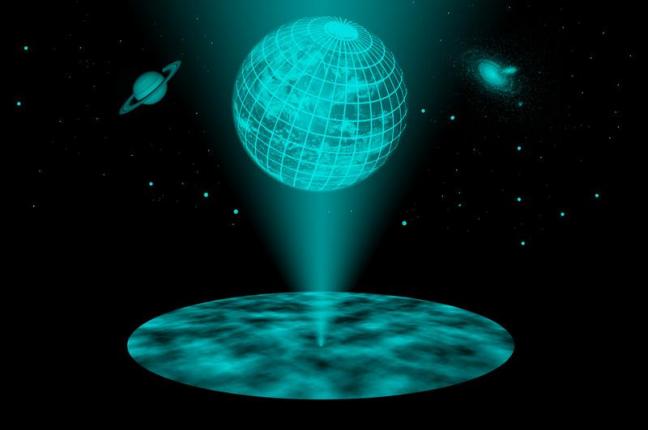Is the Universe 3-D? Or Just a Hologram?
 VIENNA, April 27 (UPI) — New and ongoing research suggests physicists are using one too many dimensions to explain the universe. They say the cosmos can be mathematically explained using just two dimensions.
VIENNA, April 27 (UPI) — New and ongoing research suggests physicists are using one too many dimensions to explain the universe. They say the cosmos can be mathematically explained using just two dimensions.
The universe isn’t 3-D, in other words, it is — as was described in a recent Vienna University of Technology press release — “the image of two-dimensional processes on a huge cosmic horizon.” The universe is a hologram.
The idea that quantum physics and gravitational theories can be solved using two dimensions has proven fruitful when applied to curved spaces — like the negatively curved space-time structures of the universe theorized by astronomer Willem de Sitter, who worked closely with Albert Einstein at the Leiden Observatory in the 1920s. These curved shapes are commonly called Anti-de Sitter spaces.
But while Anti-de Sitter spaces help work out many of Einstein’s more profound quantum theories, they don’t reflect the reality of our universe.
“Our universe, in contrast, is quite flat — and on astronomic distances, it has positive curvature,” explained Vienna researcher Daniel Grumiller.
But Grumiller thought that a correspondence could appease the mathematics of 2-D quantum physics and 3-D gravitational theories on a flat surface.
“If quantum gravity in a flat space allows for a holographic description by a standard quantum theory, then there must be physical quantities, which can be calculated in both theories–and the results must agree,” Grumiller said.
Entangled particles in a quantum system cannot be described individually, they much be measured as a singular object. The measurement is called “entropy of entanglement.” The most recent work of Grumiller and his colleagues suggests that measurement is the same in both theories — flat quantum gravity and in a low-dimension quantum field theory.
It’s the latest research to lend credence to cosmological holography.
“This however, does not yet prove that we are indeed living in a hologram — but apparently there is growing evidence for the validity of the correspondence principle in our own universe,” explained Florian Aigner, a spokesman for Vienna’s research efforts.
The ideas of Grumiller and his colleagues — from the Massachusetts Institute of Technology, the University of Edinburgh, Harvard University, the University of Kyoto and elsewhere — were published this week in the journal Physical Review Letters.
You May Also Like
|
|








